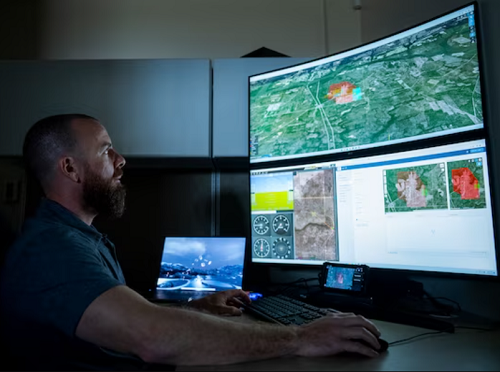The research arm of the U.S. Air Force – known as “AFWERX” – recently installed an Uncrewed Aircraft System Traffic Management or UTM network on Duke Field at Eglin Air Force Base in Florida as part of a broader effort to test whether current air traffic management systems can ensure “complete safety” as drones and electric vertical takeoff and landing or “eVTOL” aircraft begin operating more widely throughout the nation’s airspace.
[Above photo by AFWERX]
“Airspace management will play a key role for the future of air mobility and technologies like drones, eVTOLs, etc.,” said Darshan Divakaran, AFWERX’s head of airspace innovation and Prime partnerships, in a statement. “To promote technological advancements, we cannot compromise on safety. AFWERX Prime is focusing on collaborating with other agencies to ensure we can accelerate the future of air mobility in a safe and secure manner.”
At Duke Field, AFWERX and the 413th Flight Test Squadron will test both military and commercial UTM systems as part of its Collaborative Low-Altitude UAS Integration Effort or CLUE – evaluating the ability of those systems to “de-conflict” flight paths, provide communication, and airspace security management, as well as how they manage low-altitude weather and beyond visual line of sight operations.
“Eglin is going to be one of our primary proving ground location for multiple efforts across AFWERX Prime, including airspace efforts supporting Agility Prime and Autonomy Prime,” Divakaran said, creating “situational awareness” for drones and eVTOL aircraft operating at roughly 12,000 feet.
“We will have additional proving ground locations across the nation in partnership with agencies such as the Office of the Under Secretary of Defense, Federal Aviation Administration, U.S. Department of Transportation and NASA,” he noted. “We are also focusing on true public-private partnerships as we accelerate these efforts.”
Future testing at Duke Field will involve different UAS models, though they all will weigh less than 70 pounds, a size that allows them to fly more often and with fewer restrictions, said Major Riley Livermore, future flights commander and head of the 413th Flight Test Squadron
“That will provide validated data, before they integrate eVTOL, larger UAS, and other Advanced Air Mobility aircraft,” Maj. Livermore said.
State departments of transportation are engaged in similar efforts regarding drone and eVTOL aircraft operation management.
For example, in August 2022, the Ohio Department of Transportation began playing a key role in developing technology to keep airspace safe for both “manned” and “unmanned” aircraft, while also establishing an advanced air mobility or AAM framework for autonomous aircraft operation statewide.
Ohio DOT’s Office of Statewide Planning and Research along with its DriveOhio division has been working with the Federal Aviation Administration, the Ohio Unmanned Aircraft Systems Center, and Ohio State University, and industry to develop and deploy a “detect and avoid” system.
That system would track drones as a “public service” and keep them from colliding with aircraft that operate at lower altitudes like medical helicopters or crop dusters, the agency said.
 Top Stories
Top Stories
Modal Administrators Speak at AASHTO Annual Meeting
December 5, 2025 Top Stories
Top Stories

